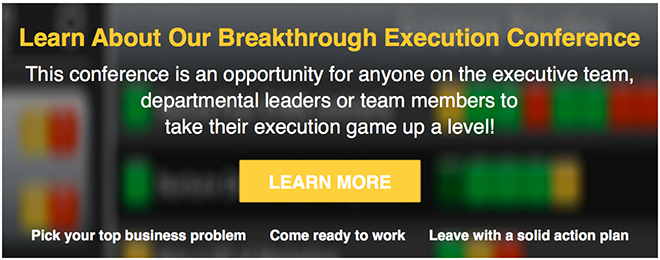Nope. The title is not a misprint. Any ship at anchor while attempting to move forward, is moving slower and  using more energy than necessary. That’s an anchor that weighs on all measure of productivity. I see them all the time in the ship called business. They look like a team member without clear objectives, accountability, or alignment to company objectives. They look exactly like an anchor on your business with one striking difference … they are hard to identify. You feel it in your gut, perhaps an intuitive feel, but you can’t measure it or take a photo. Perhaps that’s one explanation why a meager one-third of employees are fully engaged at work -- and many become disengaged. They haven’t been identified and therefor cannot be addressed.
using more energy than necessary. That’s an anchor that weighs on all measure of productivity. I see them all the time in the ship called business. They look like a team member without clear objectives, accountability, or alignment to company objectives. They look exactly like an anchor on your business with one striking difference … they are hard to identify. You feel it in your gut, perhaps an intuitive feel, but you can’t measure it or take a photo. Perhaps that’s one explanation why a meager one-third of employees are fully engaged at work -- and many become disengaged. They haven’t been identified and therefor cannot be addressed.
Dale Carnegie Training engaged MSW Research to utilize its EMO*Dynamics battery, twenty-eight positive and negative emotions proved to be important in consumer decision-making across many categories to study engagement in the workplace. They discovered that five emotions drove engagement and twelve provoked disengagement. Read the report for details.
For now, let’s zoom in on the analysis that indicates that feeling valued, confident, inspired, enthused and empowered are key emotions leading to engagement. And, that team members who feel the negative emotions of irritation, disinterest, and discomfort will disengage nearly ten times more than those who feel positive emotions. That’s a lot of anchors to weigh on the cash and productivity of your business ship.
Peter Garber has authored over 40 products related to soft skills and human capital development, including 50 Activities for Employee Engagement and 25 Legendary Leadership Activities. He’s a good source to question regarding best practices in employee engagement.
Q- Peter, is employee engagement just another word for employee motivation? Can you tell us how they’re different?
A- Obviously they are related, but the difference is that engagement is more of a management function. That is, the leaders are responsible for creating an environment of engagement. It is not realistic to expect employees to be self motivated, despite the culture in which they work. Employee engagement is all about creating the environment that gets employees to exert discretionary effort.
Q- How is engagement level reflected in business metrics?
A- As I’ve already mentioned, it all ties back to discretionary effort on the part of employees. This could be observed best in a service you receive. You can tell when you are dealing with an engaged worker; we all want to do business with employees who have the earmarks of being engaged: positive about their tasks, achieving and surpassing performance standards, and they convey commitment. You can‘t even begin to measure what the payback is!
Q- I recently read a comprehensive industry study of global employee engagement levels. This source quoted findings that fewer than 1 in 3 employees are engaged, worldwide. What does this mean about the potential for productivity gains?
A- Well, I think you are leading to an important conclusion. The reason we care about employee engagement is not just because we want to create a “kinder, gentler” workplace. Ultimately, we want our employees to become more effective and (therefore) impact the bottom line. We want everyone to feel important, relevant and engaged, but at the core, these are business initiatives. Even social service agencies have an objective to serve their client.
Q- Is the trend over the last generation of employees entering the workforce to exhibit “free agent” mentality at odds with high levels of engagement?
A- Part of the pay back from engagement is retention. The difference in mindset of what retention means is changing. For example, I have worked with the same company for 31 years. I doubt my kids will do the same. That doesn’t mean that retention isn’t important. If you can get 3-5 years of great performance from an employee, that is still much better than many turnover rates for companies with low engagement these days.
A- A gap analysis, assessment or some other way of gathering data is the logical starting point. You can also talk to people, and conduct focus groups. But the bottom line is that you’ve got to ask and measure, and follow that up with a strategic plan that has resources backing it.
At this point my mind began to wander to the patterns that I’ve seen in fast growing companies – and specifically, the patterns that emerged for the ones with fast growth year over year (not just one year). Is the above suggested gap analysis helpful? Certainly, yet – it may not be necessary. You can begin to drive engagement immediately by implementing the Rhythm® approach of planning from the top down, creating dashboards to mark progress to plans, reporting on those dashboards from the bottom up, and adjusting weekly. This creates an environment making team members feel:
- Valued– their efforts are measured and discussed with team.
- Confident– knowing day-by-day what to say no to, and when to say yes.
- Inspired– who hasn’t been inspired by watching a scoreboard while playing the game?
- Enthused – visibly seeing how we’re progressing as team and sharing good news weekly raises team enthusiasm.
- Empowered– with a clear dashboard of accountability and responsibility you create an environment.
Align from the top, build dashboards with status criteria, report from the bottom up, and make adjustments weekly. Incorporate the key emotions above and you'll be singing Anchors Aweigh (not A Weight) as you travel the seas of business success! I'll see you at the next port of call - Barry
Photo Credit: iStock by Getty Images



 LinkedIn
LinkedIn
 Facebook
Facebook
